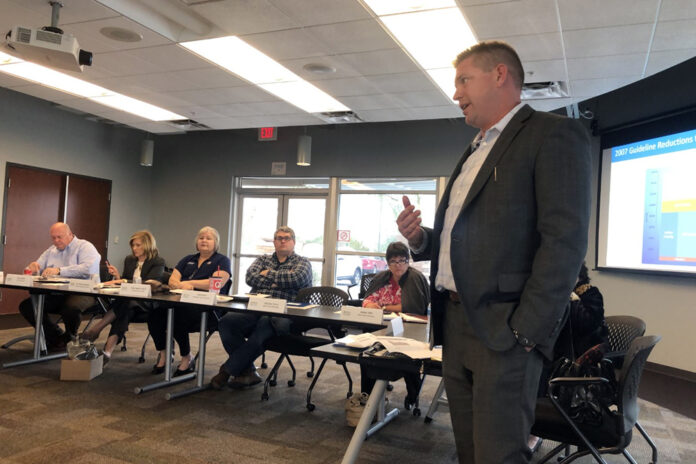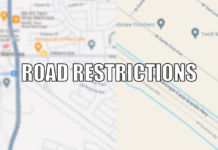
“It’s a little complicated. It’s a little chaotic right now, but it’s not a crisis.”[quote_box_right]Watch for InMaricopa’s series on the Drought Contingency Plan and Maricopa sustainability starting March 1.[/quote_box_right]
Ron Fleming, Global Water Resources president and CEO, addressed the members of the Maricopa Economic Development Alliance (MEDA) about the state’s Drought Contingency Plan on Wednesday. Fleming told the MEDA membership, “It’s just complicated, and there’s a lot going on. I haven’t checked my phone in two hours – probably something has changed.”
Fleming said his main message is, “sometimes a good crisis is needed to cause change.”
He said it is time to find the right balance in Pinal County to work together and address the water issues of the day.
The Colorado River provides water to approximately 40 million people in seven states and in Mexico. The water is provided to about 4 million acres of farm land.
“However, over the last 20 years of drought, it has had a significant impact on water in Lake Mead and Lake Powell,” Fleming said. “We are sitting here today with a historic low (water level) in Lake Mead behind Hoover Dam. That is projected to continue to decline.”
He said most people saw this trend coming many years ago and began planning for this event.
“That’s where the talks began that turned into the common name of DCP, Drought Contingency Planning,” he said.
Fleming explained how different tiers of water levels will affect the amount of water that is cut back to Arizona.
Beginning in 2020, the DCP engages when Lake Mead hits a level below 1,090 Mean Sea Level (MSL). At that point, called Tier 0, 192,000 acre feet that was going to Arizona is cut back. Tier 1 engages at 1,075 MSL and an additional 320,000 acre feet is cut.
The Colorado River is currently at 1,085 MSL.
If the water continues to fall in Lake Mead, virtually all water to entities besides Native American reservations would be stopped from flowing out of the Colorado. Even the reservations could lose some water flows in the event the levels dive too low.
“The Colorado River supply comes into Pinal County primarily for agricultural purposes. [It] was also planned to phase out by 2030,” Fleming said. “That is for different reasons and historic agreements. That was always the plan. What’s happening now under DCP and the drought conditions is that is accelerating. It is hitting immediately; more than 10 years earlier than they otherwise were able to hopefully adapt to that reality.”
He said DCP is intended to bring about larger cutbacks on a shorter timetable.
“So that we can protect Lake Mead and keep that reservoir from hitting those shortage declaration levels,” Fleming told the MEDA members.
He said the Tier 0 level on Lake Mead is already in effect.
“DCP is not intended to keep us from hitting Tier 1,” he said. “The belief is Tier 1 is going to be hit anyway. It’s really about keeping us from hitting Tier 2 and Tier 3, where a lot more dramatic reductions start to occur.”
Fleming said the Bureau of Reclamation believes there is a better than 50 percent chance that Lake Mead will hit the Tier 1 trigger as early as 2020.
“When we hit the Tier 1 reduction, it fully eliminates the agricultural pull that primarily comes into Pinal County,” Fleming said.
He said in addition to ag losing all its water, Tier 1 cuts will also start to eliminate some of the NIA (Non-Indian Agricultural) Priority Water.
“Basically, cities and tribes have been buying some of that NIA water. They do have a lot of capital dollars invested. They take that NIA water and put it to use. There are real immediate implications to cities and tribes, not just agriculture.”
Fleming explained that Arizona has junior rights to allocations of Colorado River water.
“If we hit those drought declaration levels, what is prescribed as reductions to Arizona is immediate and significant,” Fleming said. “We are not trying to pretend that we are in a different boat than the ag community. We are all in this boat together and we have to figure it out together. They are the first ones to take this most significant impact of what is going on.”
It will quickly become unlikely that any Colorado River water will be used for agriculture outside of the reservations.
“There is some mitigation being done in DCP for three years. They found a way to continue to supply around 100,000 acre feet per year, or about a quarter to a third of what they’re used to for the next three years,” Fleming said. “However, in 2023 to 2025 the mitigation changes. In the NIA pool will go from about 50 to 100 percent mitigation, depending on lake levels. That’s when you start seeing our cities’ NIA water get cut back more.
“Importantly, there is no more CAP (Central Arizona Project) ag mitigation. All renewable water supplies coming into central Arizona for agricultural (use) is gone.”
Instead of giving the ag industry surface water from the Colorado, the state, CAP and the federal government will create funding to help irrigators redevelop ground water pumping systems, according to Fleming.
Primarily, funds will be used to rehabilitate older ground water pumping wells and infrastructure that “they haven’t had to use because of the CAP water coming into the area.”
He said they will be rebuilding existing wells, drilling new wells and working on canals.
“That will result in about 70,000 acre feet per year of more groundwater pumping in the area to make up for the loss in the CAP supply,” said Fleming.
He said once the drought gets to 2026, “there is no more mitigation at all for any groups and, if we get to a Tier 3 shortage before 2026, all the mitigation stops.”
He added, “Increased groundwater pumping is not ideal. It’s just not – there’s just no way to get around it.”
Fleming said there will not likely be new groundwater entitlements issued anytime “in the near future.” This will curb development outside of established service areas, like the area served by Global Water Resources. Global Water has an assured 100-year water supply in their service area that allows them to pump much more water that what their system is currently using. This means growth can continue in Maricopa and the area served by Global Water.
“We think what will happen, ultimately, is the assured water supply holders will get some form of a haircut to make sure that our groundwater aquifer is not going to be over-mined and the assured water supply program can be put back into effect in some way. But that is to be determined,” Fleming said.






![City gave new manager big low-interest home loan City Manager Ben Bitter speaks during a Chamber of Commerce event at Global Water Resources on April 11, 2024. Bitter discussed the current state of economic development in Maricopa, as well as hinting at lowering property tax rates again. [Monica D. Spencer]](https://www.inmaricopa.com/wp-content/uploads/2024/04/spencer-041124-ben-bitter-chamber-property-taxes-web-218x150.jpg)

![3 things to know about the new city budget Vice Mayor Amber Liermann and Councilmember Eric Goettl review parts of the city's 2024 operational budget with Mayor Nancy Smith on April 24, 2024. [Monica D. Spencer]](https://www.inmaricopa.com/wp-content/uploads/2024/04/spencer-042424-preliminary-budget-meeting-web-218x150.jpg)


![Alleged car thief released without charges Phoenix police stop a stolen vehicle on April 20, 2024. [Facebook]](https://www.inmaricopa.com/wp-content/uploads/2024/04/IMG_5040-218x150.jpg)





